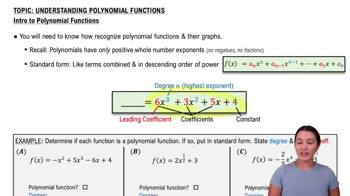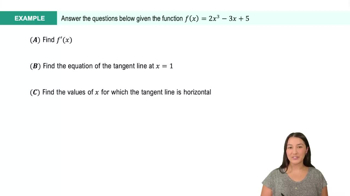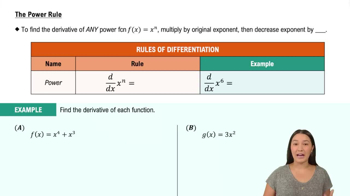Table of contents
- 0. Functions7h 52m
- Introduction to Functions16m
- Piecewise Functions10m
- Properties of Functions9m
- Common Functions1h 8m
- Transformations5m
- Combining Functions27m
- Exponent rules32m
- Exponential Functions28m
- Logarithmic Functions24m
- Properties of Logarithms34m
- Exponential & Logarithmic Equations35m
- Introduction to Trigonometric Functions38m
- Graphs of Trigonometric Functions44m
- Trigonometric Identities47m
- Inverse Trigonometric Functions48m
- 1. Limits and Continuity2h 2m
- 2. Intro to Derivatives1h 33m
- 3. Techniques of Differentiation3h 18m
- 4. Applications of Derivatives2h 38m
- 5. Graphical Applications of Derivatives6h 2m
- 6. Derivatives of Inverse, Exponential, & Logarithmic Functions2h 37m
- 7. Antiderivatives & Indefinite Integrals1h 26m
- 8. Definite Integrals4h 44m
- 9. Graphical Applications of Integrals2h 27m
- 10. Physics Applications of Integrals 2h 22m
3. Techniques of Differentiation
Basic Rules of Differentiation
Problem 63a
Textbook Question
Let f(x) = x2 - 6x + 5.
Find the values of x for which the slope of the curve y = f(x) is 0.
 Verified step by step guidance
Verified step by step guidance1
Step 1: To find the values of x for which the slope of the curve y = f(x) is 0, we need to find the derivative of f(x) with respect to x. The derivative, f'(x), represents the slope of the curve at any point x.
Step 2: Differentiate f(x) = x^2 - 6x + 5. Using the power rule, the derivative of x^2 is 2x, and the derivative of -6x is -6. The derivative of a constant, 5, is 0.
Step 3: Combine the derivatives to get f'(x) = 2x - 6.
Step 4: Set the derivative equal to 0 to find the x-values where the slope is 0. So, solve the equation 2x - 6 = 0.
Step 5: Solve for x by adding 6 to both sides and then dividing by 2. This will give you the x-value(s) where the slope of the curve is 0.
 Verified video answer for a similar problem:
Verified video answer for a similar problem:This video solution was recommended by our tutors as helpful for the problem above
Video duration:
2mPlay a video:
Was this helpful?
Key Concepts
Here are the essential concepts you must grasp in order to answer the question correctly.
Derivative
The derivative of a function measures the rate at which the function's value changes as its input changes. It is a fundamental concept in calculus that provides information about the slope of the tangent line to the curve at any given point. For the function f(x), finding the derivative f'(x) will allow us to determine where the slope of the curve is zero.
Recommended video:

Derivatives
Critical Points
Critical points occur where the derivative of a function is either zero or undefined. These points are significant because they can indicate local maxima, minima, or points of inflection on the graph of the function. In this problem, we will find the critical points by setting the derivative of f(x) equal to zero to identify where the slope of the curve is flat.
Recommended video:

Critical Points
Quadratic Functions
A quadratic function is a polynomial function of degree two, typically expressed in the form f(x) = ax^2 + bx + c. The graph of a quadratic function is a parabola, which can open upwards or downwards depending on the sign of the coefficient 'a'. Understanding the properties of quadratic functions, including their vertex and axis of symmetry, is essential for analyzing the behavior of f(x) in this problem.
Recommended video:

Introduction to Polynomial Functions

 3:59m
3:59mWatch next
Master Derivatives of Linear Functions with a bite sized video explanation from Callie
Start learningRelated Videos
Related Practice







